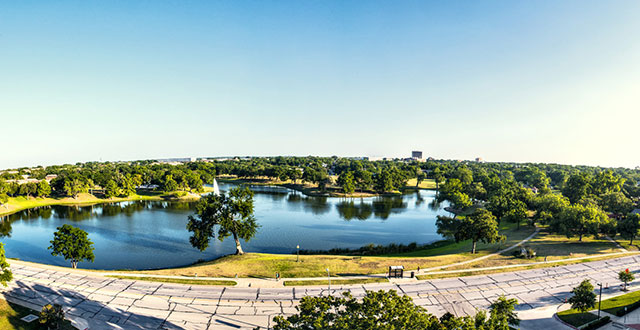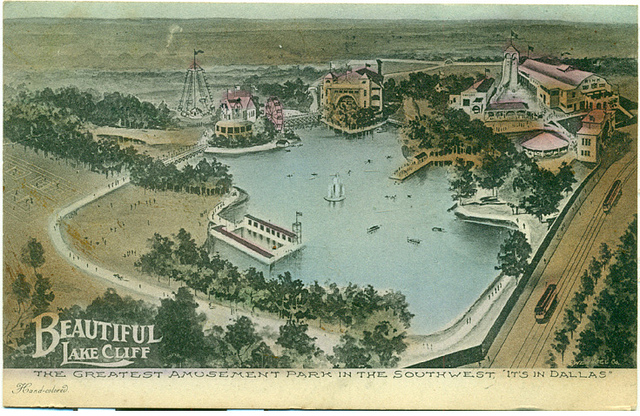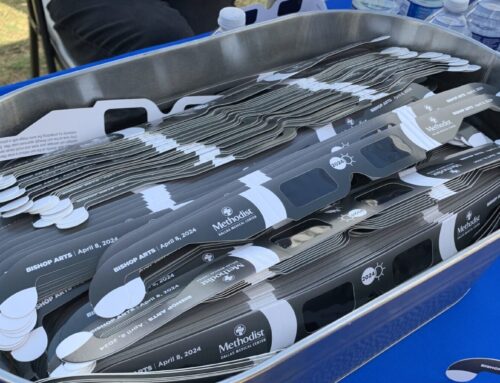
A panorama taken from Lake Cliff Tower shows a family walking together on a weekday evening: Photo by Danny Fulgencio
About 2,000 Dallas residents amassed at Lake Cliff Park when it opened to the public on July 4, 1906.
The privately owned amusement park boasted, at 18,000 square feet, “the largest skating rink in the world,” as well as amusement rides, a Ferris wheel, a casino and a three-story theater and opera house.
“Lake Cliff made Oak Cliff a destination,” says Michael Amonett of the Landmark Commission.
This month, Oak Cliff celebrates Lake Cliff’s 100th anniversary as a city park. Preservation work started on the park’s buildings and gardens in 2007, and some Oak Cliff neighbors are working on ways to bring the park into the future.
The history of the park goes back to 1890, when the lake was created for Llewellyn Park Country Club. Members and their guests could swim, fish and use rowboats on the lake.
In 1906, a newspaper described the lake as 30 acres and fed by “numberless springs,” with clear water and lots of fish.
Charles A. Mangold, who owned and operated the amusement park, eventually added a bowling alley and a “floating pool.” A fire in March 1913 destroyed the skating rink, the park’s grand entrance gate and the “shoot the chutes” amusement ride.
The city bought the park from Mangold for $55,000 in 1914, and in 1921 it installed a $65,000 pool and bathhouse. The pool closed in 1958.
The Works Progress Administration in 1934 designed formal rose gardens, and the Oak Cliff Society of Fine Arts planted 2,000 rose bushes. The WPA also built the pergolas, a pavilion, the pineapple fountain and retaining walls, which remain today.
By the 1940s, Fair Park had become the city’s amusement park, and the city changed Lake Cliff’s focus to sports. Seven tennis courts, two softball diamonds, one baseball diamond, a football and soccer field, a handball court and a volleyball court were added in the late ’40s, along with the paved path around the perimeter.
Preserving history

A vintage postcard touts Lake Cliff as “The greatest amusement park in the Southwest.” Note the streetcars in the right of the frame. The “shoot the chutes” amusement ride and the 18,000-square-foot skating rink are adjacent in the top right.
In 2007, the city renovated the pergolas, pavilion and vintage playground equipment using $1 million in bond money.
The same year, the Friends of Lake Cliff Park began designing and planting rose gardens based on the bygone WPA-era ones, with help from a grant from the Oak Cliff Lion’s Club. The rose gardens are irrigated and planted with “old-growth” roses, varieties that have been around since at least the 1850s, says Friends of Oak Cliff Parks founder Barbara Barbee.
“All the planting is paid for by donations and cared for by volunteers,” Barbee says. “This is a real community project.”
Most evenings, the park is abuzz with people exercising on the path, pick-up soccer games and children playing on the playground equipment. But the park does have problems with vandalism, Barbee says. And there are parts of the park, on the Blaylock and Fifth Street sides, that are not as heavily used.
A few neighbors have ideas for creating more uses in the park.
Disc golf
Neighborhood resident Zac Lytle first got the idea to create an Oak Cliff disc golf course — for what George Costanza on “Seinfeld” described as “frolf” or Frisbee Golf — in 2012.
He and some collaborators chose Founder’s Park — just across Colorado from Lake Cliff — as a location for nine holes.
“We’d like to use those dead spaces where nothing’s going on,” Lytle says. “Founder’s Park is so empty; it’s not safe.”
Go Oak Cliff raised about $4,000 for the disc golf course. And Lytle raised $5,000 from friends and family after he announced that the course would be named in memory of his infant son, Roger William Lytle, who died in April.
Lytle and the Oak Cliff Disc Golf Club plan to put together a demonstration of their course design at Founder’s Park during the Sept. 20 centennial celebration. Users can give feedback on what works and what could be better.
The disc golf club also wants to extend the course across Colorado into Lake Cliff Park. They even won $10,000 from the Dallas Parks Foundation in April to build the course extension there. But more recently, some neighbors have said they don’t want a disc golf course in Lake Cliff Park, which is part of the Lake Cliff Historic District.
“There’s still a lot of discussion about whether disc golf is appropriate in a historic park,” Barbee says.
Ultimately, the Park Board decides whether disc golf should be allowed at the park, but the board would be expected to vote based on the desires of the neighborhood.
And that is yet to be determined.
There are some in the neighborhood who are on board with the disc golf plan, including Ashley Peña. It would be good to have the course, especially in the underutilized back side of the park, as long as it doesn’t interrupt the playing fields or disturb historic structures, she says.
Architect Alicia Quintans of Preservation Dallas agrees.
“We want to protect the historic structures, but all the park land should be utilized for what the neighbors want, and what the community wants,” she says. “It should all be current and relevant.”
The Lake Cliff Park centennial celebration is from 5-10 p.m. Saturday, Sept. 20.





